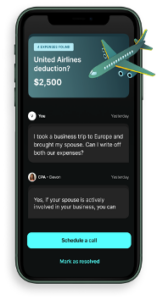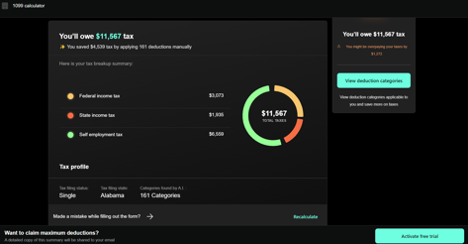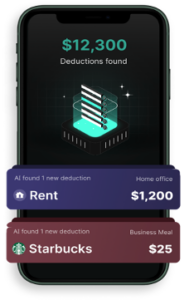This is a guest post by Varsha Subramanian, of FlyFin. Varsha is a highly experienced US CPA with a background in both tax compliance and advisory.
Working for yourself means you have ultimate control – over your business, your work life, and your future – but you’re also responsible for every aspect of your business, including taxes.
When you understand a handful of the most important tips, and you have the right checklist though, taxes can become another part of your business that you have full control and confidence over. Let us lead you through our comprehensive list of everything you need to know about freelance taxes.
How to pay the lowest tax amount possible
Step 1: Find your net income
It’s important to understand the difference between revenue and net income. Revenue, also known as gross income, is the total amount of money you’ve earned from selling products to customers or providing services to your clients.
Say you’re a freelance web designer charging $70 per hour, and you bill 10 hours in a month. 10 x $70 = $700 in revenue. Net income is what you have left after you have subtracted deductible business expenses. EX: If you sell online courses as well as freelance services, and you make $100K and have business expenses of $5,000 to host those courses, your net income will be $95,000.
It’s net income that you pay taxes on, rather than the payments you get directly from clients. This is great because net income is where tax deductions come in to make the amount you owe a lot lower.
- Identify your total revenue
- Identify any business expenses
- Calculate your net income: total revenue – expenses = net income (also known as taxable income)
That leads us to our next point, how to identify and find those expenses!

Step 2: Don’t miss a single deductible business expense
As we mentioned, deductions reduce your net income and in turn your taxes. In the eyes of the IRS any business expense that is “ordinary and necessary” for the industry you are operating in can be deducted from your taxes.
That leaves a lot of room for all sorts of deductions – 200+ categories, actually, and if you find them all, you can bring the amount of tax you owe way down! Unfortunately, it can be easy to miss deductions if you’re tediously searching through piles of receipts or spreadsheets looking for anything you can write off.
But if you find the right tools and keep track of your expenses on an ongoing basis, you’ll be much more prepared come tax season. The FlyFin app uses A.I. to scan your expenses to find every possible deduction, down to the tiniest write-off. And CPAs specializing in 1099 taxes are available 24/7 in the app for any questions. At tax time, they prepare and file your federal and state tax returns at no extra cost. Easy peasy!
Here are some of the most common deductions that freelancers can make:
- Take all the home office deductions possible if you work from home.
- Rent
- Utilities
- Internet
- Office supplies
- + many more
- Deduct every business meal when you:
- Court a prospective client
- Discuss business with friends in the same industry
- Get a referral from someone over a meal
- Have lunch with a client
- Network with industry experts
- Write off expenses related to your vehicle if you travel at all for work
- Car insurance
- Parking fees & tolls
- Gas
- Repairs & maintenance, including tires & oil changes
- Licensing and registering fees
- Lesser known deductions
- The Qualified Business Income Deduction
- ½ of the self-employment taxes every freelancer has to pay
- Expenses associated with professional education, conferences and seminars
- Meals by yourself, if you’re on a business trip, plus other travel expenses
- Music or video streaming subscriptions, if they’re for your clients
Freelancers can take deductions in over 300+ categories! Make sure you’re doing the work up-front to keep more of that hard-earned cash.
Know which taxes you need to file as a freelancer
Step 1: Calculate federal and state income tax
Knowing how much to pay in tax can be a complicated process. Fortunately, there are online calculators out there that can help. FlyFin’s super-accurate 1099 tax calculator was developed with the help of CPAs trained in 1099 taxes to help freelancers enter their details, find all the deductions they qualify for, and get a result they can rely on.
To pay your taxes accurately, it’s important to choose the right tax filing status and understand where you fall in the IRS’ tax brackets, and there are tools to help with that, too.

Step 2: Calculate self-employment taxes
The taxes that freelancers (and every taxpayer) are required to contribute to Social Security and Medicare are called self-employment taxes, or SE taxes. For employees who work for a company, these taxes are known as FICA taxes because they’re part of the Federal Insurance Contributions Act, and they’re split down the middle between the employer and the employee.
But self-employed people are required to pay both portions of self-employment tax. The rate for SECA taxes is 15.3% on net income: 12.4% for Social Security tax and 2.9% for Medicare tax, paid at the end of the year when you file your 1040 form.
Anyone who practices a trade or manages a business as a sole proprietor, independent contractor, LLC, or partnership and earns $400 or more during the tax year is required to pay self-employment taxes. So, that business your cousin has refurbishing and selling guitars makes him self-employed. As a driver for Lyft, your neighbor is self-employed, too. The freelance work your graphic designer friend does on nights and weekends after his ad agency job? Also self-employment work.
As such, all of them are required to pay 15.3% of their net income as SE Tax. But, there is a silver lining. The IRS allows you to deduct half of the 15.3% from your taxable income. You can find out how much you and much you can save with an SE tax calculator.
Step 3: Know how to file taxes in different states
If you live in one state and work in a neighboring state, how you file your taxes depends on a few things. For example, if both states require taxpayers to pay income tax, and they don’t have a reciprocity agreement that allows you to pay tax in just one state, you’ll have to pay tax on what you earn in each state.
You’ll have to file a nonresident return for the state where you work but don’t reside. You’ll need the information from this return, so you can file another tax return in your home state properly. When you file your resident tax return, your home state will usually give you a tax credit in the amount of the tax you paid in another state.
Every state has different tax rules, so make sure to consult a tax expert before preparing your tax return.
Step 4: Choose the best deduction method
When you file your taxes, you’ll want to save the most possible by making the right decision when it comes to standard deductions vs itemiized deductions. This is an important decision because the method you choose can significantly change how much you save.
The standard deduction is a fixed amount that depends on your tax filing status, for example, $19,000 for head of household. But if you claim itemized deductions instead of taking the standard deduction, you will list those deductions on Schedule A of your Form 1040. The total of all your itemized deductions is then subtracted from your taxable income.
Itemized deductions include things like medical expenses, state and local taxes, and charitable donations.
Be aware of all the documents you’ll need to complete your tax filing
When it’s time to file taxes, you can’t lower your tax bill without having the necessary documentation in place. These documents allow you to verify how much you earned and how much you spent on business expenses:
- 1099 documents
- 1099-NEC for freelance work payments
- 1099-MISC for rental and other self-employment income
- 1099-K for income processed by third-party payment services
- 1099-DIV for dividends and distributions
- 1099-INT for interest income
- Business expenses
- Bank records can serve as proof – no need for receipts any longer
- Mileage logs, if you drive for work
- Records of contributions to charity and retirement plans
- 1040-ES copies, so you know the estimated tax payments you made
- 1098 showing your mortgage interest
Consult a CPA who understands 1099 taxes
IRS rules and regulations grow more complex each year, and navigating them to get your taxes done becomes more complicated every time you sit down to fill out the forms. That’s why the help of a certified public accountant, or CPA, is more valuable now than ever before. But accessing the expertise a traditional CPA can provide is easier said than done.
Fortunately, it’s easier than ever to get CPA guidance online with greater affordability and flexibility than ever before. FlyFin’s CPA team specializes in freelancer taxes and is available through the app for unlimited free consultations 24/7 and to file your tax returns, too.
Phew, that was a lot! But we hope you feel more prepared and confident in filing and understanding your freelance taxes moving forward! Good luck this tax season, and as always, we’re rooting for you and your business’ success!





